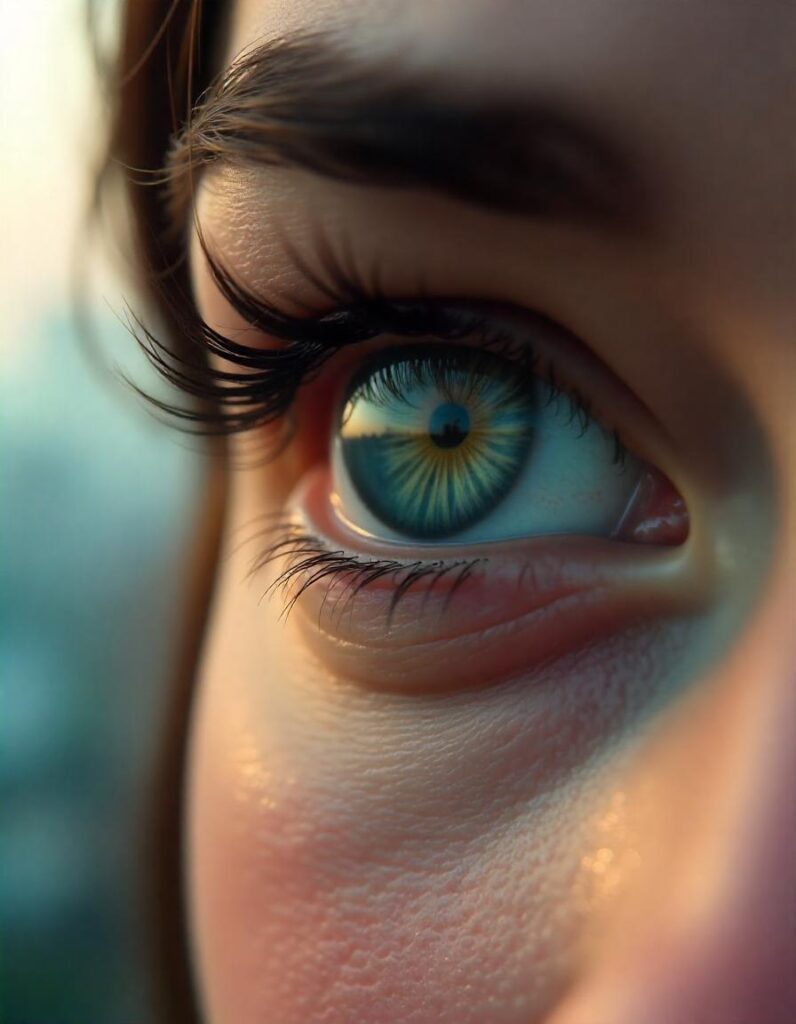Smog eye irritation is a discomfort in the eyes caused by exposure to smog, a dense air pollutant mix that includes dust, chemicals, and fine particles. Smog forms when sunlight reacts with pollutants like vehicle emissions, industrial fumes, and other contaminants, producing a harmful haze.
When our eyes are exposed to smog, they become vulnerable to irritation due to the particles and toxins in the air. Common causes of smog eye irritation include prolonged outdoor exposure, dry air conditions, and pre-existing eye sensitivity or allergies.

How Smog Affects Eye Health:
Smog poses significant risks to eye health beyond temporary irritation. The fine particles and chemical compounds in smog can break down the natural protective layer of tears over the eyes, leading to dryness and irritation.
Over time, these particles can aggravate existing conditions like dry eye syndrome and even accelerate eye aging by causing oxidative stress. Long-term exposure to smog can damage the corneal surface and affect the quality of vision, especially for people living in heavily polluted areas.
Why Do Eyes Get Irritated in Smog? The Science Behind It
Smog contains a variety of harmful particles, including sulfur dioxide, nitrogen oxides, carbon monoxide, and volatile organic compounds (VOCs). These particles disrupt the tear film—a thin, protective layer over our eyes that keeps them moist and free of dust.
When smog particles come into contact with the eyes, they can irritate the sensitive tissues, causing redness, itchiness, and a gritty feeling. In some cases, these particles can lead to inflammation or an allergic response, further irritating the eyes
Common Symptoms of Smog Eye Irritation and When to Worry
Smog eye irritation often presents as redness, itchiness, a burning sensation, and excessive tearing. Some people may experience sensitivity to light or feel like there’s something stuck in their eye.
These symptoms usually subside after leaving the smoggy area, but if they persist or worsen—especially if there is significant pain, blurred vision, or discharge—it’s important to consult an eye specialist. Persistent smog eye irritation can signal a more serious problem, such as an infection or inflammation that needs medical attention.

How to Protect Your Eyes from Smog
Urban dwellers exposed to smog on a regular basis can take steps to protect their eyes. Wearing sunglasses with UV protection helps shield the eyes from both sunlight and airborne particles. Staying indoors on high-smog days, especially during peak pollution times, is also advisable.
If you have to go outside, consider wearing protective glasses and using lubricating eye drops to keep your eyes moist. Air purifiers at home can also help reduce indoor exposure to pollutants.
Top Remedies for Relieving Smog-Induced Eye Irritation
For immediate relief from smog eye irritation, lubricating eye drops, also known as artificial tears, are highly effective. These drops help to wash out irritants and soothe dryness. Cold compresses can relieve redness and inflammation.
Washing the face and eyes after being outdoors can also help remove residual particles. For those with more severe discomfort, over-the-counter antihistamine drops can reduce allergic reactions triggered by smog particles.
Long-Term Effects of Smog on Your Eyes:
Long-term exposure to smog doesn’t just cause temporary irritation; it can lead to chronic eye issues. Over time, the constant exposure to pollutants can dry out the tear film, making the eyes more susceptible to infections and other problems like corneal damage.
In severe cases, prolonged exposure can even contribute to eye diseases such as conjunctivitis, cataracts, and age-related macular degeneration, highlighting the need for eye protection and regular eye exams in smoggy environments.
Prevention First: Steps to Reduce Eye Irritation During Smoggy Days
Preventing smog eye irritation starts with limiting outdoor exposure when air quality is poor. If you must be outside, wearing protective eyewear or goggles can prevent irritants from reaching the eyes.
Avoid rubbing your eyes, as this can worsen irritation, and wash your hands frequently to prevent transferring pollutants to your eyes. Staying hydrated also helps keep your eyes moist and protected against dryness
Smog, Pollution, and Eye Health:
Poor air quality can have far-reaching effects on eye health, as airborne pollutants reduce oxygen levels in the air and create dryness. This makes it harder for the eyes to stay hydrated and maintain a healthy tear film.
For those with sensitive eyes, pollution can cause a burning sensation or even trigger allergies. In the long run, exposure to polluted air can accelerate eye aging and contribute to vision issues
Allergy or Smog Eye Irritation?
It can be tricky to distinguish between allergies and smog eye irritation, as they share similar symptoms like redness, itching, and watery eyes. However, if your symptoms worsen specifically on smoggy days, it’s more likely due to smog.
Allergies may also come with additional symptoms like sneezing or nasal congestion. Eye drops or rinses can help in both cases, but you may need antihistamines for allergy relief.
How Smog Affects Contact Lens Wearers
Contact lens wearers are particularly vulnerable to smog eye irritation, as particles can get trapped between the lens and the eye, causing discomfort. Smog can also dry out the lenses, making them more likely to irritate the eyes.
To reduce risks, consider wearing glasses on high-smog days, or use daily disposable lenses to avoid repeated exposure. Rewetting drops designed for contacts can help maintain comfort throughout the day

Natural Remedies for Smog Eye Irritation
If you prefer natural remedies, try a cold compress or a rinse with saline solution to soothe irritated eyes. Applying cucumber slices over closed eyes can reduce inflammation, and chamomile tea bags (cooled) can relieve redness.
Some people find that consuming antioxidants, like vitamin C and E, helps protect eye health in polluted environments. Staying hydrated and using a humidifier indoors can also improve comfort
From Redness to Itchiness: Identifying the Signs of Smog Eye Irritation
Recognizing the signs of smog eye irritation can help prevent further discomfort. Symptoms include a gritty sensation, burning, and excessive watering or redness.
In some cases, there may be itching and blurred vision, which could indicate a more severe reaction. If symptoms don’t improve after taking preventive steps, consider consulting an eye specialist to assess for possible complications
Simple Lifestyle Changes to Minimize Eye Irritation in Polluted Areas
In polluted areas, small lifestyle adjustments can significantly reduce eye irritation. Wearing protective eyewear when outdoors, using an air purifier indoors, and keeping windows closed during high-smog days are simple but effective measures.
Regular eye hydration through drops, drinking plenty of water, and maintaining a balanced diet rich in eye-friendly nutrients can also make a big difference

Why Smog Can Make Dry Eyes Worse and What to Do About It
Smog exacerbates dry eye syndrome by stripping moisture from the tear film. For people with dry eyes, smog can be particularly uncomfortable. To counter this, increase your use of lubricating eye drops on smoggy days, and consider using a humidifier to keep the air around you moist. Avoid prolonged screen time, as it can worsen dryness, and make sure to blink often to keep your eyes lubricated.
To counter this, increase your use of lubricating eye drops on smoggy days, and consider using a humidifier to keep the air around you moist. Avoid prolonged screen time, as it can worsen dryness, and make sure to blink often to keep your eyes lubricated.
What is smog eye irritation?
Smog eye irritation is discomfort or irritation in the eyes caused by exposure to polluted air or smog.
What causes smog eye irritation?
It’s caused by airborne pollutants like dust, chemicals, and fine particles that irritate the eye’s surface.
What are common symptoms of smog eye irritation?
Symptoms include redness, itching, burning, and a gritty sensation in the eyes.
How can I protect my eyes from smog?
Wear sunglasses, avoid outdoor exposure on high-smog days, and use lubricating eye drops.
Are contact lens wearers more affected by smog?
Yes, smog particles can get trapped under lenses, increasing irritation for wearers.
What are some remedies for smog eye irritation?
Use artificial tears, cold compresses, and wash your face to remove pollutants.
Can smog worsen dry eyes?
Yes, smog can worsen dry eye symptoms by drying out the tear film.
How can I tell if it’s smog eye irritation or allergies?
Smog irritation occurs on high-smog days, while allergies may also cause sneezing and nasal symptoms.
Are natural remedies effective for smog eye irritation?
Yes, cold compresses and saline rinses can be effective natural relief methods.
What are the long-term effects of smog on eye health?
Prolonged exposure can lead to chronic dryness, inflammation, and even eye disease.
